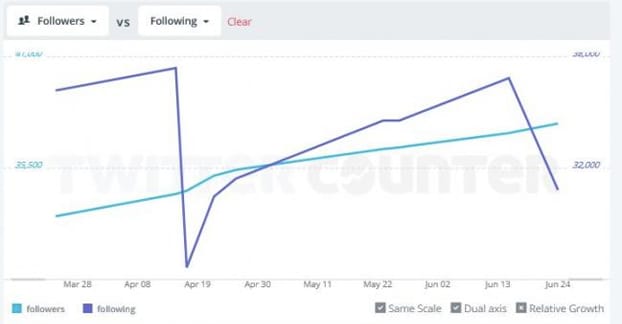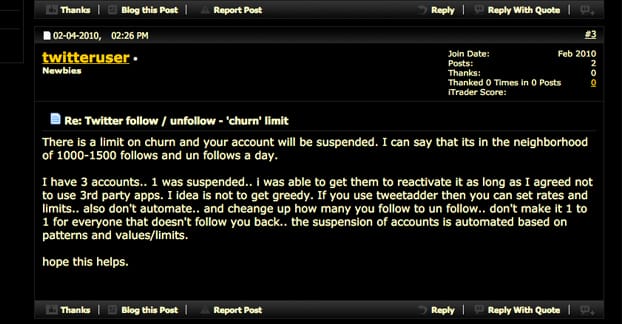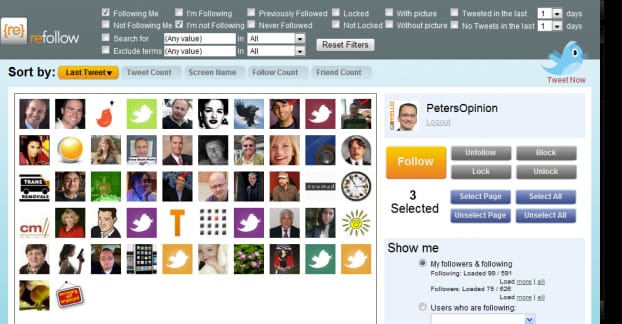If you’re learning about Twitter marketing or you’re a veteran looking to explore more advanced techniques for growing your audience, one idea you’ve probably come across is the follow/unfollow method. I like to call it the FU method, partially as an abbreviation, and partially because when you use it, what you’re saying to people is “F You.” If that seems a little harsh, well, read on.
What is the Follow Unfollow Method?
The FU method is pretty simple, all things considered, but it relies on one of two things to be true.
- The users you follow are prone to following outdated Twitter etiquette and follow back anyone who follows them.
- The users you follow use a Twitter management program that automatically follows anyone who follows them.
If one of these things is true, the method will work as intended, though there are some wrenches that can be thrown into the plan. I’ll get to those later, though.
The FU method comes in two flavors; the “legit” and the “churn”. These differ only in minor ways, and neither of them is really that legitimate. They both work to boost your followers via an artificial social exploit. It’s not really something Twitter will ban you for, but it’s less helpful than many people seem to think.
The so-called legit method starts with you defining your target audience. You need to figure out who are the kinds of people you want following you. If you’ve done social marketing before, you probably have some customer personas on hand that you can use to define this. The trouble is finding them on Twitter. You can’t use traditional advertising targeting methods for this, so you need to go based on publicly available content. Generally, this will be limited to profile information and the tweets and hashtags they use when posting. As you can imagine, this is a spotty method at best, with limited accuracy and limited scope.
When you identify these people, you follow them from your business account. This is where those two steps above come in. You’re hoping that when you follow them, they will see that you’re a business covering something they’re interested in, and they’ll follow you back.
At this point, the second difference between the legit and the churn method appears. You track the people you follow and, after a few days, unfollow anyone who didn’t follow you back. You end up dropping the people who don’t benefit you, and only keeping around the people who do. It’s highly unlikely that you’ll be keeping too many of these people around, though, because Twitter users tend to be somewhat one-sided and picky with what they follow.
Of course, you don’t actually care about following these people. With the exception of a few influencers – who probably won’t follow you back unless you’re an influencer yourself – they won’t be posting anything you care about. This method clutters your feed and makes it harder to find the posts you actually want to see. You’ll be forced to use lists or browse profiles directly, which makes Twitter a much less enjoyable experience.
The churn method is very similar to the above, except there’s a couple of major differences. The first difference is the targeting. All that stuff where you use the customer persona and identify the right people to follow? Ignore it. You’re going for volume, not value. You want 100,000 followers, not 1,000 targeted followers. You just go through Twitter’s recommendations and through the profiles of people you follow and you just follow everyone in sight.
The second step is the same; you just watch and wait a few days to see if those people follow you back. You don’t have to keep track of anything, though. It doesn’t matter, because step three is to unfollow pretty much everyone regardless of whether they followed you back at all.
This method gets you more followers faster than the churn method, but they’re not as targeted. It also gets you a better ratio of followers to following, so your business looks more like it grew organically instead of through an exploit. Of course, the growth you got is much less useful to you.
You also have Twitter itself to contend with here. If you’re following too many people too quickly, you’re likely to find yourself banned from the site. Twitter, of course, knows all about the FU method, and they know how to track to see if you’re using it. For this reason, most people recommend to stay under 100 follows a day, and to limit how quickly you churn your unfollows.
If you’re absolutely set on using this method than some form of organic growth and paid marketing, I can’t stop you. I’ll say one thing; you’re not alone. A lot of people do try to use the technique, even though it’s questionably useful. It’s also why so many Twitter apps that promote bulk follows and unfollows as features. Still, I’d like to at least take a shot at convincing you that the FU method isn’t to be trusted.
Problems with the F.U. Method
Now you can get some idea of why I like the Eff You name for the method. You as a business are saying that the number of followers you have is more important than any actual engagement with the people you follow. You’re literally picking them up, using them, abusing them, and dropping them if they don’t do exactly what you want. It’s very much a F- You to them. You’re treating them like game pieces or chips to be gathered, not as people who have things to say and engagement to engage in. So, in no particular order, here are a bunch of things wrong with the follow/unfollow method.
The follow back etiquette is long dead. It’s been a long time since Twitter was small enough to get away with automatic return follows, and even then, it was more of an etiquette thing for individual users, not for businesses. The combination of marketing abuse and things like the FU method abusing it meant people stopped return follows. Add to that all of the spambots following people to fish for followbacks and you have even more reason to never do it.
Most Twitter apps don’t do auto-follow-backs any more. Add this to the last one and you start to see a problem. Remember way at the beginning where I said this entire plan falls short if you’re relying on one of those two things to be true and neither are? That’s going to be the case more often than not. Most people don’t just blindly follow back people they don’t know or businesses that don’t interest them. Always assume that the person you follow is going to look at your account before deciding whether or not to follow you. If you’re not very, very interesting, it’s going to be one-sided for all of time.
You end up with a lot of churn. Both of the above reasons come together to equal a very low success rate with follow and unfollow. Follow 1,000 people and you’re likely to get less than 10 follows in return. That’s 990 people you have to unfollow and remember not to try to follow again, because they didn’t act the right way the first time. That’s 990 people who have the opportunity to report you for sending spam their way. That’s 990 people who are aware of what you’re doing and who may or may not approve. It’s a huge turnover and it means to get 10,000 followers, you need to follow and unfollow nearly a million people.
You end up with a lot of followers, but very few of them care about you. Assuming you stick with it long enough to get any decent returns, you’re going to end up with a lot of followers, but what good do they do you? It’d be faster and easier just to go to Fiverr and get someone to use their botnet to follow you. A whole bunch of fake or compromised accounts are just as good as what you would be getting from FU anyways. The followers you end up with aren’t going to be reading your tweets, retweeting them, clicking links, liking messages, or anything else.
Some people track who unfollows them and will unfollow you in return. This just further adds to the churn, and it makes the less-targeted method even less effective. If they see a new follower and follow you back, only to notice that you no longer follow them, they’re likely to remove their follow out of spite. There’s a certain feeling of betrayal there, that will lead to an unfollow even if the user might have liked your content. They feel used, because they were used.
Better Strategies for Growth
There are plenty of other ways to grow on Twitter. Here are a bunch of options you can use, all of which will be more effective in the long run than FU.
First, you can simply buy followers. Before you reject the idea, though, just think about it a bit. What is using PPC on Twitter if not buying followers, or traffic, or engagement? Buying followers through a legitimate third party works the same way; through advertising to a targeted audience. The difference is that where Twitter ads only work on Twitter, third party ads work on a variety of sites around the web. The key, of course, is to avoid the ultra-cheap bot sellers on sites like Fiverr. You don’t want to be full of terrible bots, you want legitimate followers.
If you’re averse to spending money, there are organic options as well. For example, you can try an organic influencer marketing scheme. It works something like this:
- Identify powerful influencers in your niche.
- Follow these people and watch for when they tweet something that interests you.
- Respond to their tweet with a comment that adds information or value to the original post.
- Continue any engagement they might provide.
This is an excellent routine and it can lead to bigger and better forms of relationship with the influencer in question. You can also move into directly sharing blog posts – yours or those from other sites – that they might not have seen but would be interested in. Becoming a tipster helps you be appreciated and helps you grow.
The end goal here is to be followed by the influencer and then, as your conversations continue, warn retweets from them. A single retweet from a powerful influencer can earn you more followers than a month of follow/unfollow, in general. Results may vary based on influencer and success with the other method, but still.
You also gain insight into your industry by following influencers, so long as your follow is more than just talk. By paying attention to what they have to say, you actually end up learning more and following trends more closely within your niche.
Another technique you can use goes all the way back to the first step of the first method; understanding your demographics and buyer personas. By understanding these people – through Google Analytics, Facebook Insights, or Twitter analytics – you can figure out what sorts of content they like to see. From there, you can tailor your content and your posts to these people.
When you post content someone wants to see, likes when they see it, and enjoys overall, you’re giving them a serious positive impression. With that impression, they are more likely to follow you to see more of that kind of content. By providing that kind of content, you will earn retweets and shares, which help you grow through other means as well.
Above all, with your content, you should be selfless. If your Twitter feed is nothing but links to your own posts, no one is going to engage and no one is going to care. If you posting interesting quips, statistics, content from other blogs, and retweets from industry authorities, you’re becoming an influencer yourself. You’re curating valuable content and adding your own content to the mix on occasion. No one begrudges an influencer a little self promotion now and then, right?
You can also find followers by checking the feeds of your current followers and looking for industry-relevant hashtags and influencers you may not have known existed. You can then work to target those people, either with paid ads or just posts to the hashtags they’re using. Take advantage of any avenue you can find to reach out to more interested people.
At the end of the day, you’re completely free to use whatever method you want for accumulating followers. You can do any and all of the above, if you desire. A mixture of follow/unfollow, paid advertising, retweeting, influencer marketing and insight manipulation can be part of a robust marketing plan. The only issue you run into is how thin and barely useful the follow/unfollow technique really is. I have yet to see a business that uses it to great effect. Many will say they have, but if you look at their accounts, it is at best one minor aspect of a much greater marketing plan.
It’s just a concept that keeps coming around; there is no easy way to get ahead on a site like Twitter. There’s no monetary or action-based shortcut you can take to save yourself the work that others have put in. Well, at least not unless you plan to just straight up buy an account with a ton of followers. Twitter frowns on that as well, of course, but they don’t often do anything about it.
Whatever it is you choose to do, stay on Twitter’s good side. Don’t overdo it with following accounts and unfollowing them days or weeks later. Try to hold on to people you follow until it’s plausible that you just unfollowed them based on their content or lack thereof.








